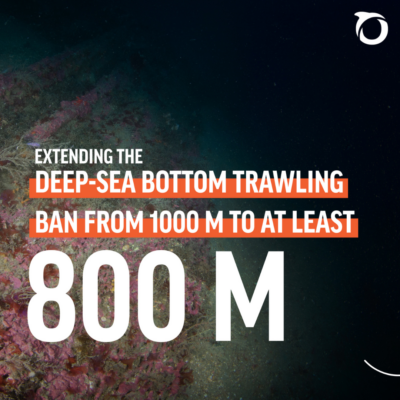The Mediterranean deep sea
The Mediterranean Sea is a global biodiversity hotspot. By volume, its waters make up less than 1% of the world’s ocean, but it is home to between 4% -18% of known marine species. However, the Mediterranean is at risk. Its coastal areas are heavily populated and under intense human pressure, and its waters are warming faster than the global average. Populations of some groups of species have suffered sharp declines in recent decades, including top predators such as sharks, rays, and marine mammals. It is a semi-enclosed deep sea – the average depth of the Mediterranean Sea is around 1500 m, but it can reach 5,000 m in its deepest parts.
The Mediterranean deep sea may help to mitigate climate change effects, and acts as a shelter for marine species from climate impacts. Oceana has campaigned to protect the Mediterranean since the creation of our office in Europe in 2003.
Banning bottom trawling in the Mediterranean deep sea
Deep-sea Mediterranean ecosystems are shaped by a remarkable variety of geological features, including seamounts, underwater reefs, canyons, and abyssal plains, and support rich biodiversity. However, they are highly sensitive to fishing impacts. Destructive fishing practices, like bottom trawling, can destroy them in one pass, as well as disturbing carbon stored in seabed sediments. Bottom trawling is currently banned in the Mediterranean below 1000 m depth. This ban was established to protect vulnerable marine ecosystems and dependent sensitive species, as well as to help recover overexploited populations. Scientific studies have shown the harmful impacts of fishing on deep-sea ecosystems, and the many benefits of banning bottom trawling in deep-sea areas, including in the Mediterranean, such as:
- More protection for vulnerable marine ecosystems
- Improved carbon storage
- Less pressure on overfished stocks
Some countries have already taken steps towards banning bottom trawling below 800 m depth. In 2024, France, Italy, and Spain, for example, established such national bans to benefit from a temporary increase in fishing days for their fleets, under the western Mediterranean multiannual plan. Spain, however, withdrew its ban shortly afterwards. Oceana is campaigning for these localised efforts to ban bottom trawling to be extended to the entire Mediterranean deep-sea, in the context of the General Fisheries Commission for the Mediterranean (GFCM).
Extending the deep-sea trawl ban
Overfishing continues to plague the Mediterranean Sea, with 58% of fish stocks currently overexploited, including popular commercial species, like European hake and blue and red shrimp, that regularly inhabit the Mediterranean depths. Recent pilot studies and surveys conducted by national scientific bodies in seven Mediterranean countries – Egypt, France, Greece, Italy, Malta, Spain and Tunisia – have demonstrated that extending the current fishing limit from below 1000 m depth to below 800 m depth would have limited or no socio-economic impact on the fleet. This finding is in line with a previous analysis conducted by Oceana, which found minimal fishing activities occurring at these depths. The area between 800 m and 1,000 m depth covers approximately 100,000 km² in the Mediterranean, and its protection would represent a key step in the conservation of marine biodiversity, the protection of vulnerable ecosystems, and the recovery of species that are currently overexploited in some Mediterranean regions.
Protecting Cabliers Bank
Until recently, Cabliers Bank was a hidden jewel in the Mediterranean Sea. The reef was discovered by Oceana in 2010 and is the only cold-water coral reef known to be growing in the Mediterranean. This underwater biodiversity treasure has survived for centuries and is a unique deep-sea biodiversity hotspot located in the Alboran Sea (the westernmost part of the Mediterranean) between Spain and Morocco. In this area, Oceana has documented dense reefs formed by vulnerable species of deep-water corals and sponges. Oceana also identified species that are Critically Endangered, such as bamboo coral (Isidella elongata), and nursery areas of overfished species, such as blackspot seabream (Pagellus bogaraveo). Both species have reached this state primarily due to bottom trawling activities. Oceana is campaigning for the protection of the Cabliers Bank from deep-sea fisheries.







